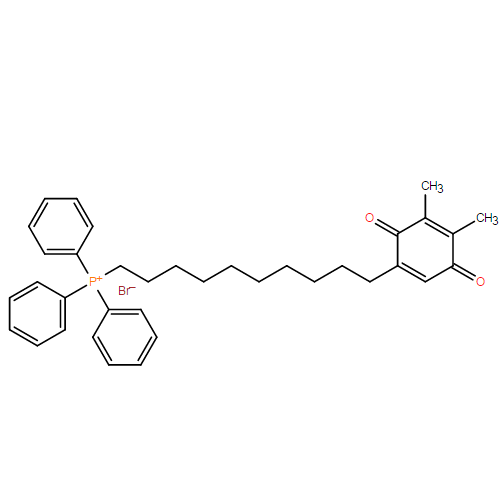| Cas No.: | 934826-68-3 |
| Chemical Name: | (10-(4,5-dimethyl-3,6-dioxocyclohexa-1,4-dien-1-yl)decyl)triphenylphosphonium bromide |
| Synonyms: | SKQ1;SKQ 1,SKQ-1 |
| SMILES: | O=C(C(CCCCCCCCCC[P+](C1=CC=CC=C1)(C2=CC=CC=C2)C3=CC=CC=C3)=C4)C(C)=C(C)C4=O.[Br-] |
| Formula: | C36H42BrO2P |
| M.Wt: | 617.6 |
| Purity: | 97% |
| Sotrage: | 2 years -20°C Powder, 2 weeks 4°C in DMSO, 6 months -80°C in DMSO |
| Description: | Visomitin is a new antioxidant with the highest mitochondrion membrane penetrating ability and potent antioxidant capability. |
| In Vivo: | Regarding systemic angiogenic factors, it is observed in serum of Pancreatic ductal adenocarcinoma (PDAC) bearing mice a decrease in KC in the group of continuous treatment with Visomitin (SkQ1). Treatment of the mice with Visomitin increases the level of VEGF molecules. The amount of MIP1a and prolactin is reduced in all Visomitin treatment groups or after the follow-up treatment, respectively. Also, an increase in the IL-6 and IL-13 amount is found in the Visomitin treated groups. TGF-b amount is decreased in the pretreatment setting. On the contrary, all schemes of the Visomitin treatment decrease the NKT cell percentage. The Visomitin treatment has prolonged the median survival of PDAC-bearing mice, but the difference does not reach the level of significance defined[1]. |
| In Vitro: | Direct treatment of tumor infiltrating leukocytes with Visomitin (SkQ1) does not influence their cytotoxicity against Panc02 cells. While Visomitin does not affect viability of the cell lines, this drug at 500 nM concentration reduces heavily the proliferation of human PDAC cells[1]. |
| Cell Assay: | Panc02 cells are treated 48 h with different concentrations of Visomitin (SkQ1). Cell viability after Visomitin treatment is measured with an EZ4U Kit as described by the manufacturers. Briefly, 20,000 cells per well are seeded in 96-wellplates and let grow overnight. Afterwards, cells are treated without the medium exchange. A substrate compound from the kit is added and the cells are further incubated for 5 hr at 37°C to convert the yellow colored tetrazolium to its red formazan derivate by living cells. The absorbance is measured at 450 nm[1]. |
| Animal Administration: | Female C57BL/6 mice are used in this study. For experiments on both acute and chronic pancreatitis, mice are divided in three groups. Group A (acute pancreatitis (AP) n=8; chronic pancreatitis (CP) n=12) is treated with 5 nmol/kg Visomitin (SkQ1), group B (AP n=8; CP n=12) is the untreated control, and group C (AP n=8; CP n=7) is the sham group, which is injected intraperitoneally with 0.9% NaCl instead of cerulein and is therefore the negative control group without pancreatitis. For experiments on acute pancreatitis, mice are pretreated with Visomitin for 8 weeks prior to induction of pancreatitis. Mice designated for experiments on chronic pancreatitis receive Visomitin at the same concentration for 8 weeks in parallel with induction of pancreatitis[2]. |
| References: | [1]. Bazhin AV, et al. The novel mitochondria-targeted antioxidant SkQ1 modulates angiogenesis and inflammatory micromilieu in a murine orthotopic model of pancreatic cancer. Int J Cancer. 2016 Jul 1;139(1):130-9. [2]. Weniger M, et al. The Analgesic Effect of the Mitochondria-Targeted Antioxidant SkQ1 in Pancreatic Inflammation. Oxid Med Cell Longev. 2016;2016:4650489. |

 DC Chemicals' products qualify for U.S. tariff exemptions. We guarantee no price increases due to customs duties and maintain stable supply, continuing to deliver reliable research solutions to our American clients.
DC Chemicals' products qualify for U.S. tariff exemptions. We guarantee no price increases due to customs duties and maintain stable supply, continuing to deliver reliable research solutions to our American clients.





















